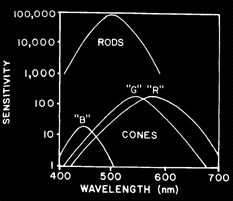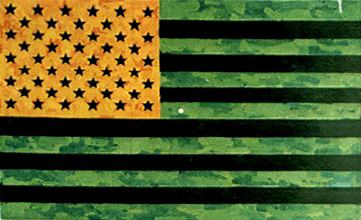

![]()
Colour Vision
 |
Visible light is part of the electromagnetic spectrum, a very small part as you can see in the diagram left. Just to the left is infrared radiation or heat. Our eyes are not sensitive to it but it feels warm to our skin. On the other side is ultraviolet radiation. It increases the pigmentation in our skin or damages it. Bees can see ultraviolet light but don't see little red. |
 |
Our eyes focus images onto the retina on the inside rear surface of the eyeball. The retina has 100 million rods that are very sensitive to light and 6 million cones that provide colour vision. The retina itself is as fragile as a piece of wet tissue paper. A bundle of nerve fibers (the optic nerve) exiting the rear of the eye carry the signals from the rods and cones to the brain. At low light levels only the rods are active, consequently there is no colour vision in dim light. As light intensity increases beyond the threshold of colour vision then the colours appear to change, at first blues appear too weak due to the lower sensitivity of the blue cones. There is thought to be complex processing of the signals from the cone so that only two discrete signals are received by the brain. The reproduction below of a painting by Jasper Johns demonstrates a fatigue effect of the colour receptors. If you stare for some time at the spot in the centre of the flag then quickly transfer your gaze to the white rectangle you should see a flag with white stars on a blue background and red and white stripes, the complementary colours. |
 |
 |
The colour of a background against which an object is viewed influences the perceived colour of the object in the direction of the colour complementary to the background colour. It is interesting to note that in some cultures there are no separate words for blue and green while in others yellow and orange are not distinguished. If you look at the additive colours on the Color page, the secondary colours yellow, cyan and magenta are popular with Asian peoples whereas western people find them garish. Likewise the tertiary additive colour, white is the colour for funerals but westerners find the subtractive colours more to their liking and black is worn at funerals.
| Return to | Color or go on to plants |